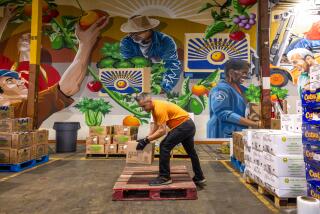Goodwill Casting Off Its Old Image : Training: No longer an old clothes bin or appliance repair and resale shop, the organization has turned to teaching disabled people the high-tech trade and marketing their skills, but it’s off to a slow start.
- Share via
SANTA ANA — Salomon Flores Reyna refers to an arcane diagram, then moves a tiny component into place on a computer-circuit board. His job prospects limited by a bum leg, the 22-year-old native of Mexico hopes that the assembly skills he is learning will help him to support his family when he returns to Acapulco.
A year ago, Goodwill Industries of Orange County opened a high-tech assembly training program in Santa Ana to help bright but partially disabled people such as Reyna. Goodwill works with the program’s participants to market their skills to local high-tech and aerospace manufacturers.
The workers get free training and are paid an hourly wage; Reyna gets $5.50 an hour while he learns. The program is a potential source of revenue for Goodwill, a nonprofit organization. Goodwill Industries of San Jose, which operates a similar high-tech assembly training program, has generated up to $4 million in annual business, with the money used to pay for other programs.
But the local Goodwill program is off to a slow start. It is attracting only a quarter of the business that Goodwill officials had hoped it would, or about $25,000 a month.
George Kessinger, president of Goodwill Industries of Orange County, thinks he knows why. He says that Goodwill has to overcome its image as “the trailer where you drop off your clothes.”
“I think people say to themselves, ‘I don’t want my computer put together there, thank you.’ ”
The recession that hit in the last half of 1989--resulting in hundreds of local layoffs at computer and aerospace firms--didn’t help much either.
To turn things around, Goodwill hired a new program director, Steve Smithling, a former production supervisor for a Garden Grove electrical-assembly firm. And it is trying to train its workers in specific areas where it believes that there will soon be a shortage of skilled workers.
Local Goodwill officials are also considering giving the training program a name of its own to separate it from the Goodwill name. “I’m personally not very warm to the idea” of the name change, Kessinger said. “I feel people should accept opportunities and people as they are.”
Started in the early 1900s by a Methodist minister, Goodwill originally helped the poor by collecting unwanted household goods and employing men and women to repair them for resale. The organization’s mission has evolved over the years into training people and placing them in jobs in the community. About half of the national organization’s annual operating revenue of $600 million still comes from selling used goods.
High-tech assembly is the newest training program for Goodwill in Orange County. It also trains people in food services, janitorial services, retail sales, general assembly, office skills and in other areas.
About two years ago, local Goodwill officials took a close look at Orange County businesses to figure out where they could place more disabled people in jobs. The high-tech industry, which employs 7% of Orange County workers, seemed an obvious answer. Goodwill spent $150,000 to renovate part of its Santa Ana building. The initial goal was ambitious: $100,000 a month by the end of the first year. The figure didn’t seem unreasonable, given the San Jose example.
But so far, only 55 customers have used the services and only 12 people have been trained through the program. Many of the customers are one-time users who want Goodwill to build a prototype.
Will Rhame, president of Expression Machine in San Diego, recently contracted with Goodwill to build a vending machine that lets people make their own bumper stickers. He said one of his employees had worked for Goodwill in the past, and he decided to check out the program.
“Their bid was so good that it’s even competitive with the prices I would get if I went to Mexico,” Rhame said. “Goodwill needs to change people’s perceptions. Based on the prices, they should be inundated by people from all over the country.”
Goodwill’s Smithling has been attending trade shows and has a potential niche picked out for Goodwill. Many high-tech manufacturers are beginning to use a production technique known as surface-mounting, which allows them to produce ever-smaller circuit boards.
But Smithling believes that as many assemblers are trained in the new technique, there will still be a demand for workers familiar with traditional assembly operations. Explained Kessinger: “We’re looking for regular, steady work and training for people in the high-tech industry. We’re not on the creative fringe of electronics.”
More to Read
Inside the business of entertainment
The Wide Shot brings you news, analysis and insights on everything from streaming wars to production — and what it all means for the future.
You may occasionally receive promotional content from the Los Angeles Times.










